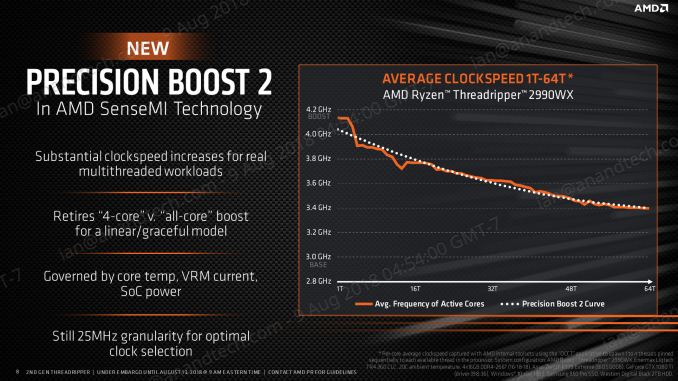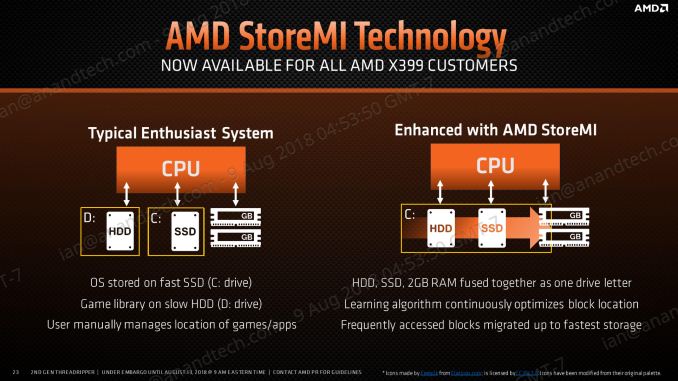The AMD Threadripper 2990WX 32-Core and 2950X 16-Core Review
by Dr. Ian Cutress on August 13, 2018 9:00 AM ESTPrecision Boost 2
Exact per-core turbo timings for the new processors will be determined by AMD’s voltage-frequency scaling functionality through Precision Boost 2. This feature, which we covered extensively in our Ryzen 7 2700X review, relies on available power and current to determine frequency, rather than a discrete look-up-table for voltage and frequency based on loading. Depending on the system default capabilities, the frequency and voltage will dynamically shift in order to use more of the power budget available at any point in the processor loading.
The idea is that the processor can use more of the power budget available to it than a fixed look up table that has to be consistent between all SKUs that are stamped with that number.
Precision Boost 2 also works in conjunction with XFR2 (eXtreme Frequency Range) which reacts to additional thermal headroom. If there is additional thermal budget, driven by a top-line cooler, then the processor is enabled to use more power up to the thermal limit and get additional frequency. AMD claims that a good cooler in a low ambient situation can compute >10% better in selected tests as a result of XFR2.
Ultimately this makes testing Threadripper 2 somewhat difficult. With a turbo table, performance is fixed between the different performance characteristics of each bit of silicon, making power the only differentiator. With PB2 and XF2, no two processors will perform the same. AMD has also hit a bit of a snag with these features, choosing to launch Threadripper 2 during the middle of a heatwave in Europe. Europe is famed for its lack of air conditioning everywhere, and when the ambient temperature is going above 30ºC, this will limit additional performance gains. It means that a review from a Nordic publication might see better results than one from the tropics, quite substantially.
Luckily for us we tested most of our benchmarks while in an air conditioned hotel thanks to Intel’s Data-Centric Innovation Summit which was the week before launch.
Precision Boost Overdrive
The new processors also support a feature called Precision Boost Overdrive, which looks at three key areas for power, thermal design current, and electrical design current. If any of these three areas has additional headroom, then the system will attempt to raise both the frequency and the voltage for increased performance. PBO is a mix of ‘standard’ overclocking, giving an all core boost, but gives a single core frequency uplift along with the support to still keep Precision Boost trying to raise frequency in middle-sized workloads, which is typically lost with a standard overclock. PBO also allows for idle power saving with a standard performance. PBO is enabled through Ryzen Master.
The three key areas are defined by AMD as follows:
- Package (CPU) Power, or PPT: Allowed socket power consumption permitted across the voltage rails supplying the socket
- Thermal Design Current, or TDC: The maximum current that can be delivered by the motherboard voltage regulator after warming to a steady-state temperature
- Electrical Design Current, or EDC: The maximum current that can be delivered by the motherboard voltage regulator in a peak/spike condition
By extending these limits, PBO gives rise for PB2 to have more headroom, letting PB2 push the system harder and further. PBO is quoted by AMD as supplying up to +16% performance beyond the standard.
AMD also clarifies that PBO is pushing the processor beyond the rated specifications and is an overclock: and thus any damage incurred will not be protected by warranty
StoreMI
Also available with the new Ryzen Threadripper 2 processors is StoreMI, AMD’s solution to caching by offering configurable tiered storage for users that want to mix DRAM, SSD, and HDD storage into a single unified platform. The software implementation dynamically adjusts data between up to 2GB of DRAM, up to 256 GB of SSD (NVMe or SATA), and a spinning hard drive to afford the best reading and writing experience when there isn’t enough fast storage.
AMD initially offered this software as a $20 add-on to the Ryzen APU platform, then it became free (up to a 256GB SSD) for the Ryzen 2000-series processors. That offer now extends to Threadripper. AMD’s best case scenario is citing a 90% improvement in loading times.













171 Comments
View All Comments
Lolimaster - Monday, August 13, 2018 - link
Then build one yourself.tmnvnbl - Monday, August 13, 2018 - link
How did you measure power numbers for core/uncore? Did these validate with e.g. wall measurements? The interconnect power study is very interesting, but I would like to see some more methodology there.seafellow - Monday, August 13, 2018 - link
I second the ask...how was measurement performed? How can we (the readers) have confidence in the numbers without an understanding of how the numbers were generated?GreenReaper - Wednesday, August 15, 2018 - link
Modern CPUs measure this themselves. AMD itself has boasted of the number of points at which they measure power usage throughout its new CPUs. Check out 'turbostat' in the 'linux-cpupower' package - or grab a copy of HWiNFO that will show it.Darty Sinchez - Monday, August 13, 2018 - link
This here article be awesome. I is so ready to buy. But, me no have enough money so I wait for it sale.perfmad - Monday, August 13, 2018 - link
So is the 2990WX bottlenecking in Handbrake because of the indirect memory access for some cores? Would be interesting to know if that bottleneck can be worked around by running multiple encodes simultaniously, The latest Vidcoder beta uses the handbrake core and has recently added support for multiple simultanous encodes. Would be really appreciated if you had time to look into that.Also do you share the source file and presets you use for the handbrake tests so we can run them on our hardware to get a comparison? My CPU isn't one you've tested.
Thanks for the review thus far.
AlexDaum - Monday, August 13, 2018 - link
I think, the problem with the memory bandwidth cannot be easily fixed, as it isn't a Problem, that one Process uses to much memory, but one core on one of the dies without memory controller, needs to access the infinity fabric to get Data. When all of the cores are active and want to fetch data from memory, it would cause contention on the IF Bus, which reduces the available memory bandwidth a whole lot and the core is just waiting for memory.This is just my speculation though, not based on facts, other than the bottleneck.
Aephe - Monday, August 13, 2018 - link
Those 2990WX Corona results! Can't wait to get a machine based on this baby! Holding up for TR2 release was worth it for me at least.Ian Cutress - Monday, August 13, 2018 - link
That benchmark result broke my graphing engine ! Had to start reporting it the millions.melgross - Monday, August 13, 2018 - link
It’s interesting. This reminds me of Bulldozer, where they made a bad bet with floating point (among some other things), and that held then back for years. This looks almost too specialized for most uses.